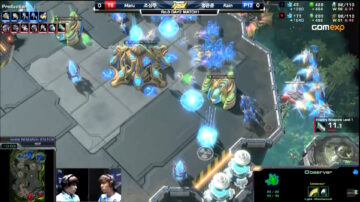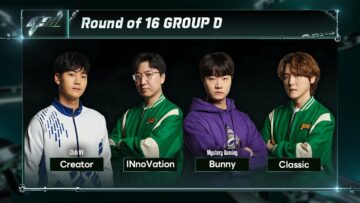Maru marched one step closer to winning a fifth GSL Code S title, dispatching his round-of-sixteen opponents in Group B to advance in first place. After flexing his late-game TvZ prowess against Solar, Maru fought off a spirited challenge from Dream in the winners match to secure his first place finish.
While Maru taking first place was a largely expected outcome, the second place race delivered a surprise as Dream took two series off of Cure to secure a playoff berth. Proxy-Barracks shenanigans were rampant in the matches—Dream even managed to win his initial match against Cure in under seven minutes of total game time.
After the matches, TY appeared to give his final sign-off as the color commentator on the Korean stream. JYP is set to return to his old seat, having recently completed his military service (TY had originally joined the commentary desk as JYP’s replacement).
Code S will continue on Monday, Apr 12 9:30am GMT (GMT+00:00) with Group C of the round-of-sixteen, featuring Rogue, Zoun, INnoVation, and Dark.
![[image loading]](https://platoaistream.net/wp-content/uploads/2021/04/code-s-ro16-maru-dream-advance-to-ro8.png)
Match Recaps
Initial Match #1: Maru vs Solar
Game 1 – Deathaura: Maru opened with blue-flame Hellions from two Factories, successfully masking the build and nabbing a few Drone kills as a result. Maru followed-up by attacking with Hellbats, following up again with Drilling Claw Mine drops. While Maru was unable to do any game ending damage, he succeeded in keeping Solar pinned down on his side of the map. Meanwhile, Maru’s growth was almost completely unhindered, and the Team NV ace set himself up beautifully for his preferred, half-map-split style of play.
But instead of suffering a slow and painful death, Solar found a way to break through his opponent’s turtle stance. As Maru looked to secure his rich-Vespene expansion, Solar launched a beautiful enveloping maneuver with Lurker, Banelings, and Vipers. The attack took out two Terran expansions, and set Maru scrambling to reestablish his defensive lines. Solar didn’t give Maru the time he needed to recover, finding the weak spots in Maru’s stretched-out defense line and attacking with more waves of Zerg. Maru was unable to fully stabilize and eventually GG’d to Solar’s relentless attacks.
Game 2 – Romanticide: Despite sending out an Overlord to look specifically for proxies, Solar just barely missed discovering Maru’s 2-Rax cheese. Still, Solar managed to pull off a good initial defense, using his Drones to prevent a Bunker from going up and chasing off the Marines. However, Solar let his guard down too soon, and paid the price for cancelling a Spine Crawler when Maru launched an off-tempo attack with more Marines. Maru microed his way to a great trade against Solar’s Queens and Lings, putting himself ahead in the low-econ game.
Maru then applied more pressure with Hellbats and Banshees, keeping Solar on his toes and preventing him from droning up. When Maru finally brought Tanks and Stimmed Marines for a dedicated push, Solar simply didn’t have the army or economy to handle it and tapped out.
Game 3 – Pillars of Gold: Solar finally got off to a good start in the series, establishing a strong economy after shutting down Maru’s attempts to harass with Hellbats and Banshees. Predictably, Maru went into super-turtle mode (which he may have done anyway off a good start), leaving Solar to spread Creep and take expansions unopposed.
Perhaps due to the loss on Deathaura, Maru played his turtle-style even more patiently than usual, sticking to five bases for as long as possible before trying to extend his defensive line to take additional bases. This seemed to work out for the most part, with Solar’s Lurker-Viper-Baneling swarms unable to find the same kind of game-winning opening as on Deathaura.
Despite playing excruciatingly slowly and ceding map control to Solar for most of the game, Maru seemed to have his win condition firmly in mind: Don’t let Solar take any of the expansions on the Terran half of the map. Maru cautiously pressed forward when Solar tried to ‘steal’ expansions, and ultimately succeeded in maintaining the 50/50 balance of expansion control. Slowly but surely, this put Solar on a timer. As the resources on his side of the map were drying up, he couldn’t find a way to take any engagements that didn’t put him at a terrible resources-lost deficit. When Solar tech-swapped to Brood Lords and Infestors, Maru simply added Thors and Vikings to his composition to continue the standoff.
Maru stayed fully committed to his turtling approach, refusing to move out even after Solar had mined out all of the expansions on his half of the map. Eventually, Solar had no choice but to dive directly into the teeth of the Terran defense, something Maru had been waiting for all along. Superior spellcaster usage helped Maru take a decisive victory, sealing his 2-1 series win.
Initial Match #2: Cure vs Dream
Game 1 – Deathaura: Cure went for a full 1/1/1 proxy build while Dream built one Barracks in his main and a second one out on the map. Cure’s decision to go for a Reactor on his Barracks resulted in him getting completely destroyed in build order rock-paper-scissors, with Dream’s 2-Rax Reapers entering Cure’s completely undefended main to take a three minute win.
Game 2 – Lightshade: Both players sent out SCVs early to proxy again, which resulted in them meeting briefly in the middle of the map before going on to carry out their cheesy plans. Once again, Dream got the build order advantage of 2-Rax Reaper versus 1-Rax 1-Factory, netting him another free win.
Winners’ Match: Maru vs Dream
Game 1 – Pillars of Gold: A normal-ish TvT was finally played, with Maru going for Medivac-Tank harass while Dream played a defensive Cyclone build. Maru’s superior micro allowed him to win a skirmish at Dream’s ramp and place his Tank in a painful position for Dream, killing off a Reactor and forcing a Barracks float. Dream seemed to pay Maru back by sneaking a Raven into Maru’s territory, killing off a decent number of SCVs with autoturrets. However, it ended up being an unwise use of energy, as Maru would soon launch a frontal attack with a handful of Tanks and two of his own Ravens. Maru’s autoturrets ended up playing a crucial role in the fight, allowing him to crush Dream’s army and force the GG.
Game 2 – Jagannatha: Proxy Reaper tomfoolery resumed in game two, with both players building one Barracks in their mains while proxying their second Barracks out on the map. A mutual test of multi-tasking ensued, with both players trying to harass and defend against harassment at the same time. The skirmishing went surprisingly evenly early on, with neither player taking a meaningful advantage in army or worker count.
The game ended up being decided by the two players’ choice in follow-ups. Dream continued to crank out Reapers while looking to double expand behind it. On the other hand, Maru only made a single additional Command Center while looking to transition out of Reapers and go up to Starport tech. Dream’s superior squad of Reapers hit Maru when he was weakest, just as he started adding Hellions to his army. Dream took out a ton of SCVs before Hellions could clean up the Reapers, leaping ahead with an enormous advantage. Instead of trying to vainly play the game out, Maru cynically conceded defeat after scanning Dream and realizing how far ahead his opponent was.
Game 3 – Oxide: Both players went for Tank-Medivac openers, with the opposing Medivacs briefly meeting up in the middle of the map before continuing on their ways. Maru opted to drop his payload in Dream’s natural, forcing a float and halting SCV production for a while. On the other hand, Dream dropped Maru’s main, taking out a Reactor but not affecting Maru’s economy. This trade ultimately ended up working in Maru’s favor, as he took an economic lead. Maru jumped further ahead with his Banshee follow-up, sacrificing it to kill off a number of SCVs.
Feeling the need to get something done, Dream moved out with a force centered on 3 Tanks and 2 Ravens. However, Maru wasn’t lacking in Tanks or Ravens on his end and ended up crushing Dream’s troops with ease. Maru then counter-attacked to complete the 2-1 victory and stamp his playoff ticket.
Losers’ Match: Cure vs Solar
Game 1 – Romanticide: Cure went for a greedy double-expand build off a Reactor-Barracks, while Solar pulled off a successful blind counter with a 16 Pool before Hatchery. Solar’s initial six Zerglings arrived in a completely undefended Terran base, managing to kill a handful of SCVs and disrupt mining significantly. Seeing that Cure had gone for a risky double expand build, Solar followed up with a Roach-Ling all-in to get a quick victory.
Game 2 – Jagannatha: Cure opened up by going for Hellion-Banshee, getting a decent return of six Drone kills. Cure stayed on the offensive, attacking once he had a single Tank and a handful of Stim-upgraded Marines. This attack did a surprising amount of damage, with Cure’s Tank positioning and good micro allowing him to take a fantastic trade against Solar’s Zerglings and slow Banelings. Solar couldn’t replenish his defenses in time to handle the next wave of Terran invaders and GG’d out.
Game 3 – Pillars of Gold: Solar gambled on a 16 pool build again, this time against Cure’s Reaper expansion. Solar’s Zerglings managed to dodge the path of Cure’s first Reaper, and snuck into the Terran base to kill three SCVs and delay Cure’s expansion.
Cure decided to go for Hellion-Banshee play once more, but was unable to inflict any damage this time around. On the other hand, Solar went for a sneaky fast Spire, looking to catch Cure by surprise with Mutalisks. This tactic almost worked for Solar, but Cure’s Hellions just barely caught sight of Mutalisks flying across the map. This resulted in Solar barely doing any damage to Cure—an unenviable position for any Zerg who’s gone fast Mutas.
Once Cure had 1/1 infantry upgrades, he moved out with his Marines and Tanks to lay siege to Solar’s fourth base. Despite having later upgrades and a weaker army than he would have liked, Solar managed to survive and defend his fourth base against several waves of Terran attackers. However, Cure’s economy and production was continuing to grow unimpeded, while Solar was still left playing in catch-up mode. As is often the case in TvZ, the Zerg player just couldn’t survive the Terran’s inevitable 3/3 power spike, with Solar being overrun before his own 3/3 upgrades or Ultralisks could make an impact.
Decider Match: Cure vs Dream
Game 1 – Oxide: Dream continued the proxy wars, going for another 2-Rax proxy Reaper strategy. Even though Cure played a normal 1-Rax tech build this time around, Dream’s good Reaper micro managed to net him a decent number of unit and SCV kills. In any case, neither player gained a major advantage, leaving them to build up relatively passively for a while.
Dream decided to go on the offensive again once he had three Tanks and two Ravens, setting up a siege just outside of Cure’s base. Cure took the risk of splitting his forces up, going for a backdoor Marine drop while attempting to defend at home. This chaotic exchange ended up going in Dream’s favor, gaining an army lead at the cost of minor economic losses. While Dream couldn’t push into any of Cure’s bases, he was able to use his advantage to seize map control and place his Tanks in advanced positions on the map. And, more importantly, he was able to add Vikings to his army sooner and take control of the skies.
After some sporadic Marine skirmishes, Cure made a decisive move that would kick off the ending sequence of the game. Taking advantage of Dream’s forward position, he airlifted a large detachment of Marines behind enemy lines to attack some of Dream’s bases. This move caught Dream off guard, allowing Cure to kill off a large number of SCVs and take down some Command Centers. However, Dream wouldn’t give Cure any time to convert that economic advantage in an army advantage. Adding Liberators to his army, Dream finally set about ending the Tank standoff to push into Cure’s bases. Unfortunately for Cure, he couldn’t find an answer for Dream’s methodical Tank-Viking-LIberator advance. Eventually, he was forced to take a desperation fight into Dream’s entrenched army, after which he GG’d.
Game 2 – Pillars of Gold: Dream opened with 1-Tank 1-Medivac harassment while Cure opted for a fast Banshee instead. The two harassment tactics ended up being a wash, with both players able to kill six SCVs. Cure looked to get some further harassment done with his first Raven, but only really succeeded in wasting energy and giving Dream a window to push with his own Ravens and Tanks. However, Cure managed this difficult situation well, stalling Dream’s Tank push while sending a backdoor Marine drop to raze Dream’s third base. Then, after consolidating some defensive forces at home, Cure dislodged Dream’s encroaching tanks to take a solid lead.
Cure wasn’t in a position to finish Dream off, but managed to keep him semi-contained as both players looked to build up for the late-game. Cure’s initial advantage seemed to slip away as the arms race continued, with both players maxing out and building multiple Starports to make a late-game air transition. However, Dream’s decision to go to Battlecruisers ended up costing him against Cure’s choice of mass Ravens. When it came time to clash in a decisive battle, Cure’s superior Raven count allowed him to prevail and extract the GG from Dream.
Game 3 – Nautilus: Game three saw Dream take an advantage in terms of both build order and starting position luck. While Cure went for a Factory-before-CC build, Dream opened up with a Reaper expansion that gave him a slight economic edge. Furthermore, Dream spawned bottom-left while Cure started top-left, meaning Cure’s base was exposed to all sorts of harassment by air. Dream quickly capitalized on this, going for a Hellion drop and killing off a few SCVs. On the other hand, Cure couldn’t get anything done with his fast tech, with his Tank-Raven push getting stopped by a timely Bunker from Dream.
While Dream was in position to slowly snowball his lead, the game took a chaotic turn when the two Terran armies clashed in a mid-game fight. Cure’s Interference Matrixes made a much bigger impact than Dream’s turrets, allowing Cure to edge ahead in Tank count despite being behind in army supply overall. This was further exacerbated as Dream went for a big drop in Cure’s main, which ended up being another dubious exchange of Tanks for Marines.
With a considerable Tank advantage, Cure pushed forward to try and lay siege to Dream’s bases. Dream made the daring decision to respond by launching yet another big drop into Cure’s exposed main base. Caught in an awkward position between two bases, Cure decided to push on ahead and start a basetrade. Unfortunately for Cure, that race started with his Barracks being immediately camped by Dream’s Marines, while his own forces still had significant ground to cover before they could affect Dream’s production. Dream had more than enough troops to defend his main by the time Cure arrived, forcing the production-less Cure to GG out.
Source: https://tl.net/forum/starcraft-2/571759-code-s-ro16-maru-and-dream-advance-to-ro8
- Additional
- ADvantage
- Army
- around
- Attacks
- backdoor
- Battle
- build
- Building
- Catch
- caught
- challenge
- closer
- code
- Commentary
- continue
- cure
- Defense
- delay
- destroyed
- DID
- Disrupt
- Dodge
- drone
- Drones
- Drop
- dropped
- Early
- Economic
- economy
- Edge
- energy
- exchange
- Expand
- expansion
- FAST
- Finally
- First
- Forward
- Free
- full
- game
- Giving
- Gold
- good
- great
- Group
- Grow
- Growth
- harassment
- Home
- How
- HTTPS
- image
- Impact
- info
- Innovation
- IT
- keeping
- Kills
- Korean
- large
- launch
- lead
- Line
- Long
- looked
- major
- map
- Match
- Military
- Mining
- move
- net
- order
- Other
- Pay
- player
- pool
- power
- pressure
- preventing
- price
- Production
- proxy
- queens
- Race
- Ramp
- Recover
- Resources
- Risk
- scanning
- Seize
- Series
- set
- setting
- SIX
- solar
- spread
- start
- started
- Strategy
- successful
- supply
- surprise
- tactics
- tech
- test
- time
- Ton
- trade
- Versus
- Wave
- waves
- WHO
- win
- Work
- work out









![[ASL17] Ro24 Preview Pt1: Fresh Start](https://platoaistream.net/wp-content/uploads/2024/02/asl17-ro24-preview-pt1-fresh-start-360x392.jpg)


